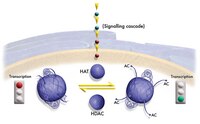Fluorescent penetration enhancers for transdermal applications.
Jennifer E Seto,Baris E Polat,Brett Vanveller,Renata F V Lopez,Robert Langer,Daniel Blankschtein
Journal of controlled release : official journal of the Controlled Release Society
158
2012
Show Abstract
Chemical penetration enhancers are often used to enhance transdermal drug delivery. However, the fundamental mechanisms that govern the interactions between penetration enhancers and skin are not fully understood. Therefore, the goal of this work was to identify naturally fluorescent penetration enhancers (FPEs) in order to utilize well-established fluorescence techniques to directly study the behavior of FPEs within skin. In this study, 12 fluorescent molecules with amphiphilic characteristics were evaluated as skin penetration enhancers. Eight of the molecules exhibited significant activity as skin penetration enhancers, determined using skin current enhancement ratios. In addition, to illustrate the novel, direct, and non-invasive visualization of the behavior of FPEs within skin, three case studies involving the use of two-photon fluorescence microscopy (TPM) are presented, including visualizing glycerol-mitigated and ultrasound-enhanced FPE skin penetration. Previous TPM studies have indirectly visualized the effect of penetration enhancers on the skin by using a fluorescent dye to probe the transdermal pathways of the enhancer. These effects can now be directly visualized and investigated using FPEs. Finally, future studies are proposed for generating FPE design principles. The combination of FPEs with fluorescence techniques represents a useful novel approach for obtaining physical insights on the behavior of penetration enhancers within the skin. | 22062691
 |
Critical function of the CD40 pathway in parvovirus B19 infection revealed by a hypomorphic CD40 ligand mutation.
Frank Blaeser,Michael Kelly,Karen Siegrist,Gregory A Storch,Richard S Buller,Jessica Whitlock,Nga Truong,Talal A Chatila
Clinical immunology (Orlando, Fla.)
117
2005
Show Abstract
Parvovirus B19-induced chronic anemia has been associated with failure to mount an effective neutralizing antibody response. We describe an adolescent male with a 13-year history of parvovirus B19-induced anemia as the primary manifestation of X-linked hyper IgM immunodeficiency (XHIM). This patient, whose serum IgG concentration was at the low end of the normal range and who mounted IgG antibody responses to T cell-dependent antigens, suffered from a nonsense mutation (R11 --> X) in the CD40 ligand (CD40L) gene. This resulted in low-level expression of a mutant CD40L predicted to lack the cytoplasmic domain. Intravenous immunoglobulin therapy alone or in combination with interferon gamma, given in the context of impaired Th1 cytokine production, suppressed but did not eradicate the infection. These results highlight the critical function of the CD40/CD40L pathway in parvovirus B19 infection and suggest that subtle defects in this pathway may underlie cases of chronic parvovirus B19 infection atypical of XHIM. | 16169277
 |

















[AB951-I_IHC(P)-ALL].jpg)

